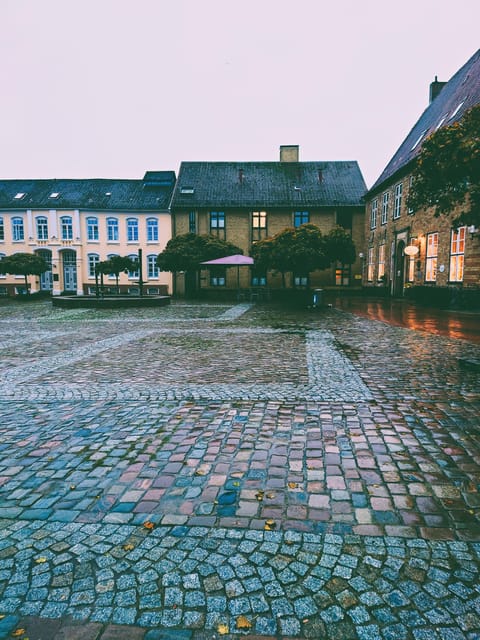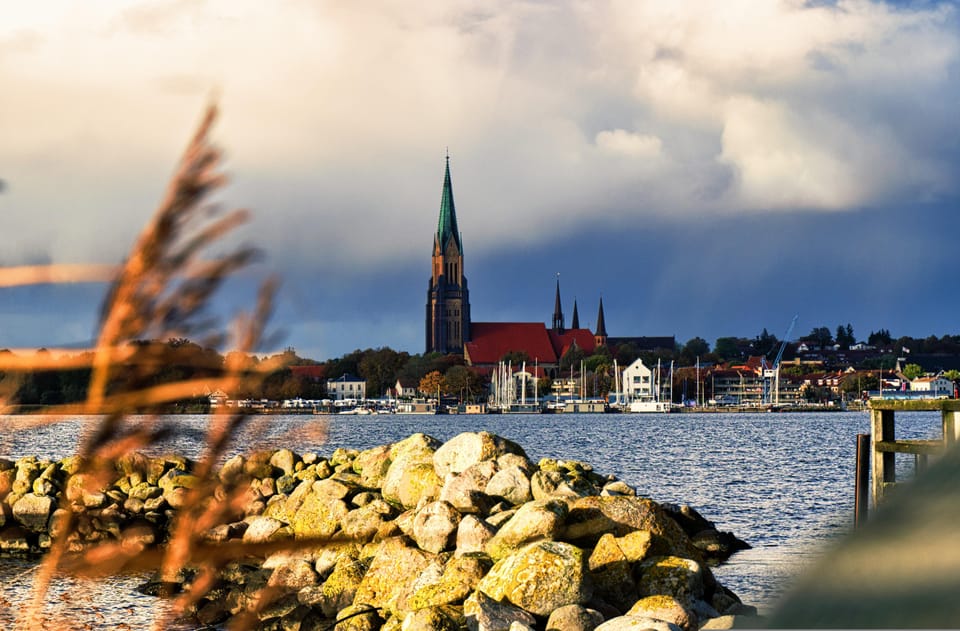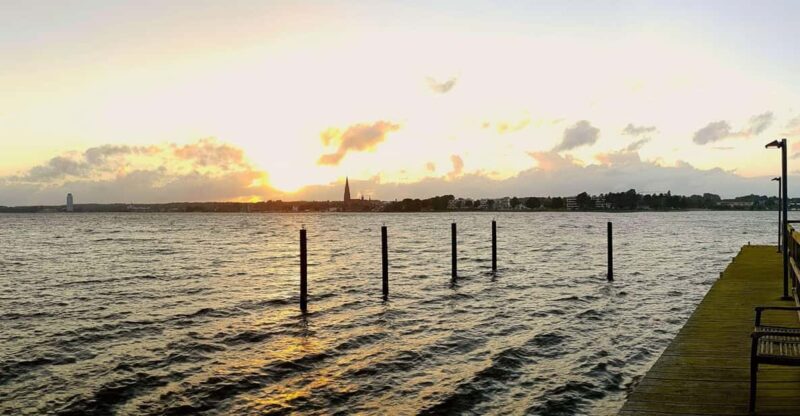Medieval Schleswig was a captivating fusion of Viking lore, royal legacy, and monastic mischief. Situated along the Schlei, this bustling trading hub attracted merchants and influenced regional politics. From the architectural grandeur of Danish kings to the intellectual pursuits of St. John’s Monastery, the city’s vibrant past is etched into its very fabric. Uncover the intriguing stories that shaped this resilient society, where the bold exploits of seafaring warriors coexisted with the quiet contemplation of devoted clerics. Explore Schleswig’s rich cultural heritage and discover how its strategic location forged a unique identity that continues to intrigue and fascinate.
Key Points

- Schleswig’s strategic location along the Schlei made it a prominent trading hub in the early Middle Ages, attracting merchants from across Europe.
- The Danish kings recognized Schleswig’s importance and sought to exert their influence, leading to its association with royal power.
- The well-preserved medieval architecture in Schleswig’s old town and the Holm fishing settlement reflect the region’s rich cultural heritage.
- The Schleswig Cathedral and St. John’s Monastery were influential hubs of religious and intellectual life, showcasing the role of monastic orders in the area.
- The Schlei’s importance as a vital shipping route was crucial to Schleswig’s prosperity, though its significance declined over time due to navigation challenges.
Schleswig’s Storied History

Schleswig’s long-standing historical significance dates back to its prominence as a major trading hub in the early Middle Ages.
Strategically located along the Schlei, an important shipping route, the city thrived on its bustling harbor and commercial ties.
Over time, however, Schleswig lost its dominance in trade networks, its fortunes shifting with the changing political landscape.
The city’s association with Danish kings, who recognized its strategic value, remains a central part of its storied past.
Today, Schleswig’s well-preserved medieval architecture and cultural heritage offer visitors a glimpse into its illustrious history as a nexus of Vikings, kings, and monks.
You can also read our reviews of more tours and experiences in Germany.
Highlights of the Tour

Exploring Schleswig’s storied past, the tour offers a captivating glimpse into the city’s rich history, from its days as a prominent Viking trading hub to its significance to Danish kings.
Highlights include an exterior tour of the majestic Schleswig Cathedral, a stroll through the picturesque old town, and a visit to the charming Holm fishing settlement.
Participants will also explore the well-preserved St. John’s Monastery, gaining insight into the reputation of Schleswig’s monks.
The tour culminates in a cozy experience at the city’s harbor, where visitors can enjoy the maritime atmosphere that defined Schleswig’s prominence in the early Middle Ages.
The tour provides visitors with:
- A deeper understanding of Schleswig’s role as a significant trading center.
- Insights into the influence of Danish kings on the city’s history.
- Appreciation for the architectural and cultural heritage of Schleswig.
- Opportunities to connect with the city’s vibrant maritime past.
Exploring Schleswig’s Old Town

As visitors stroll through Schleswig’s picturesque old town, they can’t help but be captivated by the charming historic buildings and quaint cobblestone streets.
The tour explores this well-preserved medieval core, offering a glimpse into the city’s prosperous past as a significant trading hub. Highlights include the bustling city harbor, where fishermen once plied their trade, and the Holm fishing settlement, a testament to the community’s maritime heritage.
Throughout the tour, the guide shares insights into Schleswig’s role as a center of power for Danish kings and the influential presence of the region’s monastic orders, providing a rich historical context to the urban landscape.
Holm Fishing Settlement
The Holm fishing settlement, nestled along the banks of the Schlei, offers visitors a unique glimpse into Schleswig’s rich maritime heritage. This quaint enclave was home to generations of fishermen, who carried on the traditions of their craft.
Visitors can explore the well-preserved medieval houses, imagining the daily life of these hardy seafarers. The tour highlights several key aspects of the Holm’s significance:
-
The fishermen’s historical rights, reaffirmed by King Christian I in 1480, showcasing the important role they played in the local economy.
-
The Schlei’s strategic importance as a major shipping route during the early Middle Ages.
-
The close-knit community and unique culture that developed around the fishing industry.
-
The contrast between the Holm’s modest dwellings and the grandeur of Schleswig’s royal and religious centers.
St. John’s Monastery
St. John’s Monastery is a well-preserved medieval structure that offers insight into Schleswig’s monastic history.
As part of the guided tour, visitors can explore this impressive religious complex. The monastery was founded in the 13th century and served as a hub for education and spiritual contemplation.
Today, its beautifully preserved architecture and artifacts provide a glimpse into the lives of the devout monks who once resided there.
Through the tour, visitors gain a deeper understanding of the influential role the monastery played in Schleswig’s past and the enduring legacy of its religious communities.
Schleswig’s Harbor Experience
Amidst the picturesque old town of Schleswig, one can’t help but be drawn towards the cozy city harbor.
This historic waterfront, once a bustling center of trade, now offers visitors a glimpse into the past.
The harbor experience includes:
- Observing the traditional fishing boats and their hardy crews, a testament to Schleswig’s maritime heritage.
- Strolling along the tranquil quaysides, taking in the sights and sounds of the working harbor.
- Exploring the nearby Holm fishing settlement, where the rights of fishermen have been protected for centuries.
- Appreciating the strategic importance of the Schlei, the waterway that once connected Schleswig to the wider world.
Significance of the Schlei
Historically, the Schlei waterway proved pivotal to Schleswig’s prominence as a trading hub during the early Middle Ages. This natural inlet connected the city to the Baltic Sea, enabling the effortless movement of goods and people.
Schleswig’s strategic location along this vital shipping route allowed it to flourish as a bustling commercial center, with merchants and seafarers from across Europe visiting its lively harbor.
However, over time, the Schlei’s importance waned as larger vessels struggled to navigate its narrowing channels, leading to a gradual decline in Schleswig’s trading significance.
Today, the Schlei remains a testament to the city’s illustrious past as a hub of medieval commerce and exploration.
Insights Into Local Culture

The historical rights of Holm fishermen, reaffirmed by King Christian I of Denmark in 1480, provide a fascinating glimpse into the cultural traditions of medieval Schleswig.
This fishing settlement along the Schlei estuary was known for its hardy, self-reliant inhabitants who weathered the ebb and flow of regional power struggles.
Key cultural insights include:
-
The Holm fishermen’s right to freely navigate the waters and access the harbor, safeguarded by royal decree.
-
The reputation of Schleswig’s monks, who were renowned for their intellectual pursuits and administrative roles within the community.
-
The enduring importance of the Schlei as a vital shipping route, despite Schleswig’s diminished prominence in regional trade networks.
-
The resilience of local customs and livelihoods in the face of shifting political landscapes.
Frequently Asked Questions
Is the Tour Available in Languages Other Than German?
The tour is available in German, but the overview indicates that a live tour guide is provided. So it’s possible the tour may be available in other languages upon request or depending on the guide’s capabilities.
Can I Purchase Tickets on the Day of the Tour?
Yes, you can purchase tickets on the day of the tour. The tour offers a reserve now & pay later option, allowing you to secure your spot without immediate payment.
Is There a Minimum Group Size Required for the Tour?
The tour doesn’t have a minimum group size requirement. Individuals can book and participate in the tour independently. The tour is open to both individual travelers and small groups interested in exploring Schleswig’s historical highlights.
Are There Any Discounts Available for Seniors or Students?
The tour offers a 10% discount for seniors and students. Child tickets are also available at a reduced rate. Discounts can be selected when booking the tour online or by contacting the tour operator directly.
How Much Time Do We Have to Explore the Sites on Our Own?
The tour allows approximately 30 minutes of free time for self-exploration at the sites. Participants can wander the picturesque old town, visit the harbor, and discover the medieval St. John’s Monastery at their own pace during this time.
Recap
Schleswig’s vibrant past echoes through its historic landmarks and enduring traditions. From the influential kings to the curious monks, this coastal town’s story is woven into the fabric of its architecture, cultural heritage, and bustling harbor. Visitors can enjoy Schleswig’s captivating legacy, uncovering the region’s rich tapestry of Viking lore, royal legacies, and spiritual contemplation that shaped its remarkable history.
You can check availability for your dates here:More Tour Reviews in Germany
Not for you? Here's more nearby things to do in Germany we have reviewed
- Dachau Memorial Public Tour
- Berlin Highlights Self guided scavenger hunt and Walking Tour
- 2 Hours E-Scooter Tour
- Private audio book city rally around Stuttgarts old town
- Private Wheelchair Accessible Berlin Shore Excursion from Warnemünde Port
- Private day trip from Munich to Salzburg, Hallstatt & back
- Berlin Third Reich & Cold War Walking Tour With A Guide
- ENGLISH GUIDED BIKE TOUR HAMBURG – Alsterlake District (min.4)
- The best in Baden-Baden surroundings and Black Forest. Start from Baden-Baden
- Private Tour from Munich to Eagle’s Nest and Salzburg
- Baden-Baden mysterious jewel of Black Forest
- Hamburg: City Pass with 40+ Attractions & public transport
